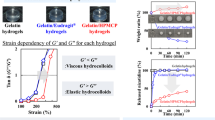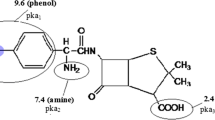Abstract
The current study delineates the development of gelatin–amylopectin-based phase-separated hydrogels for drug delivery applications. Gelatin and amylopectin were used as the representative protein and polysaccharide phases, respectively. The hydrogels were prepared by adding different proportions of amylopectin to gelatin solutions and subsequently cross-linking the mixture using glutaraldehyde. Microscopic analysis showed formation of phase-separated hydrogels. Secondary structure of gelatin was conserved within the hydrogels. The presence of amylopectin drastically reduced the rate of water absorption by the hydrogels. Viscoelastic analysis using stress relaxation study suggested an increase in the viscous component of the hydrogels with the increase in the amylopectin content. After incorporating amylopectin within the gelatin hydrogel, even though the bulk resistance remained unaltered, there was a corresponding variation in the capacitive elements of the equivalent electrical models. The release of the drug from the hydrogels was diffusion mediated. Suitable mathematical models were used for the analysis of the swelling (Peleg’s model), viscoelastic (Weichert model), electrical (RQQ model) and drug release (Korsmeyer–Peppas and Peppas–Sahlin models) properties. The drug retained its antimicrobial activity within the hydrogels. An analysis of the results suggested that the developed hydrogels may be explored as matrices for controlled drug delivery applications.





Similar content being viewed by others
References
Bourriot S, Garnier C, Doublier JL (1999) Micellar-casein–κ-carrageenan mixtures. I Phase separation ultrastructure. Carbohydr Polym 40:145–157
Kasapis S, Morris ER, Norton IT, Clark AH (1993) Phase equilibria and gelation in gelatin/maltodextrin systems—part I: gelation of individual components. Carbohydr Polym 21:243–248
Antonov YA, Moldenaers P (2011) Structure formation and phase-separation behaviour of aqueous casein–alginate emulsions in the presence of strong polyelectrolyte. Food Hydrocoll 25:350–360
Matalanis A, McClements DJ (2012) Factors influencing the formation and stability of filled hydrogel particles fabricated by protein/polysaccharide phase separation and enzymatic cross-linking. Food Biophys 7:72–83
Pok S, Myers JD, Madihally SV, Jacot JG (2013) A multilayered scaffold of a chitosan and gelatin hydrogel supported by a PCL core for cardiac tissue engineering. Acta Biomater 9:5630–5642
Gupta B, Tummalapalli M, Deopura B, Alam M (2014) Preparation and characterization of in situ crosslinked pectin–gelatin hydrogels. Carbohydr Polym 106:312–318
Hoffman AS (2012) Hydrogels for biomedical applications. Adv Drug Deliv Rev 64:18–23
Xiao W, Liu W, Sun J, Dan X, Wei D, Fan H (2012) Ultrasonication and genipin cross-linking to prepare novel silk fibroin–gelatin composite hydrogel. J Bioact Compat Pol. doi:10.1177/0883911512448692
Krishnamoorthy G, Sehgal PK, Mandal AB, Sadulla S (2013) Development of D-lysine-assisted 1-ethyl-3-(3-dimethylaminopropyl)-carbodiimide/N-hydroxysuccinimide-initiated crosslinking of collagen matrix for design of scaffold. J Biomed Mater Res A 101:1173–1183
Erizal E, Perkasa DP, Abbas B, Sudirman S, Sulistioso G (2014) Fast swelling superabsorbent hydrogels starch based prepared by gamma radiation techniques. Indo J Chem 14:246–252
Bertoft E, Annor GA, Shen X, Rumpagaporn P, Seetharaman K, Hamaker BR (2016) Small differences in amylopectin fine structure may explain large functional differences of starch. Carbohydr Polym 140:113–121
Li S, Yang Y, Yang X, Xu H (2007) In vitro degradation and protein release of semi-IPN hydrogels consisted of poly (acrylic acid-acrylamide-methacrylate) and amylose. J Appl Polym Sci 105:3432–3438
Li S (2010) Removal of crystal violet from aqueous solution by sorption into semi-interpenetrated networks hydrogels constituted of poly (acrylic acid-acrylamide-methacrylate) and amylose. Bioresour technol 101:2197–2202
Campos E, Coimbra P, Gil MH (2013) An improved method for preparing glutaraldehyde cross-linked chitosan–poly (vinyl alcohol) microparticles. Polym Bull 70:549–561
Jin W, Xu W, Ge H, Li J, Li B (2015) Coupling process of phase separation and gelation in Konjac glucomannan and gelatin system. Food Hydrocoll 51:188–192
Boons K, Noriega E, Van den Broeck R, David CC, Hofkens J, Van Impe JF (2014) Effect of microstructure on population growth parameters of Escherichia coli in gelatin-dextran systems. Appl Environ Microbiol 80:5330–5339
Singh VK, Sagiri SS, Khade SM, Bhattacharya MK, Pal K (2015) Development and characterization of gelatin–polysaccharide based phase-separated hydrogels for prevention of sexually transmitted diseases. J Appl Polym Sci. doi:10.1002/app.41785
Firoozmand H, Rousseau D (2013) Microstructure and elastic modulus of phase-separated gelatin–starch hydrogels containing dispersed oil droplets. Food Hydrocoll 30:333–342
Vatankhah E, Prabhakaran MP, Jin G, Mobarakeh LG, Ramakrishna S (2014) Development of nanofibrous cellulose acetate/gelatin skin substitutes for variety wound treatment applications. J Biomater Appl 28:909–921
Serra I, Fradique R, Vallejo M, Correia T, Miguel S, Correia I (2015) Production and characterization of chitosan/gelatin/β-TCP scaffolds for improved bone tissue regeneration. Mater Sci Eng C 55:592–604
Kipcak AS, Ismail O, Doymaz I, Piskin S (2014) Modeling and investigation of the swelling kinetics of acrylamide-sodium acrylate hydrogel. J Chem 2014: Article ID 281063
Trifković K, Milašinović N, Djordjević V, Zdunić G, Krušić MK, Knežević-Jugović Z, Šavikin K, Nedović V, Bugarski B (2015) Chitosan crosslinked microparticles with encapsulated polyphenols: water sorption and release properties. J Biomater Appl 30:618–631
Fitzgerald MM, Bootsma K, Berberich JA, Sparks JL (2015) Tunable stress relaxation behavior of an alginate-polyacrylamide hydrogel: comparison with muscle tissue. Biomacromolecules 16:1497–1505
Meghezi S, Couet F, Chevallier P, Mantovani D (2012) Effects of a pseudophysiological environment on the elastic and viscoelastic properties of collagen gels. Int J Biomater. doi:10.1155/2012/319290
Asthana S, Goyal P, Dhar R, Uvanesh K, Pampanaboina NB, Christakiran J, Sagiri S, Khanna M, Samal A, Banerjee I (2015) Evaluation extracellular matrix–chitosan composite films for wound healing application. J Mater Sci Mater Med 26:1–11
Kishi R, Kubota K, Miura T, Yamaguchi T, Okuzaki H, Osada Y (2014) Mechanically tough double-network hydrogels with high electronic conductivity. J Mater Chem C 2:736–743
Warren H, Gately RD, O’Brien P, Gorkin R (2014) Electrical conductivity, impedance, and percolation behavior of carbon nanofiber and carbon nanotube containing gellan gum hydrogels. J Polym Sci Pol Phys 52:864–871
Argin S, Kofinas P, Lo YM (2014) The cell release kinetics and the swelling behavior of physically crosslinked xanthan–chitosan hydrogels in simulated gastrointestinal conditions. Food Hydrocoll 40:138–144
Zhang J, Fu M, Zhang M, Xu L, Gao Y (2014) Synthesis of oxidized glycerol monooleate-chitosan polymer and its hydrogel formation for sustained release of trimetazidine hydrochloride. Int J Pharm 465:32–41
Babić MM, Božić BĐ, Božić BĐ, Filipović JM, Ušćumlić GS, Tomić SL (2015) Evaluation of poly (hydroxyethyl acrylate/itaconic acid) hydrogels for controlled delivery of transition metal complexes with Oxaprozin as potential antiproliferative agents. J Mater Sci 50:6208–6219
Machín R, Isasi JR, Vélaz I (2013) Hydrogel matrices containing single and mixed natural cyclodextrins. Mechanisms of drug release, Eur Polym J 49:3912–3920
Acknowledgments
Authors acknowledge the support provided by National Institute of Technology, Rourkela for the completion of this study. The authors would like to extend their sincere appreciation to the Deanship of Scientific Research at King Saud University for its funding through the Research Group Project No. RG 1435-015.
Author information
Authors and Affiliations
Corresponding authors
Ethics declarations
Conflict of interest
The authors declare no conflict of interest.
Electronic supplementary material
Below is the link to the electronic supplementary material.
Rights and permissions
About this article
Cite this article
Yadav, I., Shaw, G.S., Nayak, S.K. et al. Gelatin and amylopectin-based phase-separated hydrogels: An in-depth analysis of the swelling, mechanical, electrical and drug release properties. Iran Polym J 25, 799–810 (2016). https://doi.org/10.1007/s13726-016-0468-y
Received:
Accepted:
Published:
Issue Date:
DOI: https://doi.org/10.1007/s13726-016-0468-y




